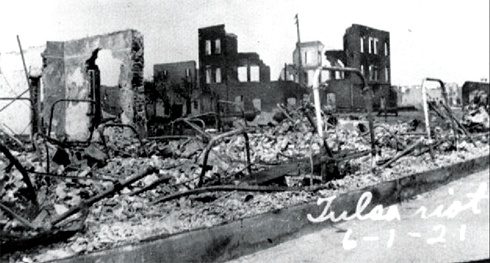Tulsa race riots are unfortunate part of state history


(Courtesy Department of Special Collections, McFarlin Library, Universityof Tulsa.)
Hundreds of prominent African-American business and property owners thrived in the city of Tulsa in 1921.
The Greenwood district — known as little Africa or Black Wall Street — is where many African-Americans lived out what most people would view as the American dream.
That is, until May 31 when an event triggered one of the most tragic moments in Oklahoma history.
According to the Oklahoma Historical Society, the Tulsa Race Riots stemmed from a rape allegation made by a white woman Sarah Page. Page, an elevator operator said she had been raped by Dick Rowland, a black shoe shiner, in broad daylight on a public elevator.
It was reported in many archives about the riots that rising tensions already existed in the area due to many of the blacks there being financially stable while many of the whites struggled.
Reports of a white woman being raped by a black man added fuel to that fire.
Homes, businesses and bodies were burned. People were dragged out of their homes, beaten and killed.
Many unarmed black men, women and children were shot. Some were hanged.
There were even reports of a bomb being dropped from the air.
According to a report filed by the Oklahoma Commission to Study the Tulsa Race Riot of 1921, after the riots were over many blacks were sent to detention camps.
A number of blacks were denied medical attention and died. Some of the dead were placed in mass graves.
Many of the African-Americans who died on this day had little or no identification, leading to them being buried in unmarked graves.
The Commission report states that damages were estimated at $1.5 million. More than $4 million in claims were filed but all were denied.
Later, two claims were reported being paid in the sum of $5,000 total.
Reparations were never made to the black community for property or damages.
History Professor Ron Gray said the Tulsa Race Riots were the worst incident of racial violence in American History.
“An entire African-American community was burned down to the ground,” he said.
Gray said the Ku Klux Klan was very powerful in Oklahoma during that time.
“Due some racial attitudes in Oklahoma during that time, it was not surprising that no whites were ever sent to prison for the deaths,” he said.
“Most of the blacks had to live through the winter months in tents because their homes had been destroyed.”
Daniel Davis, a graphics art major at OCCC, said he was unaware of the riots.
“I am not from Oklahoma but I have been living here for many years and did not know that this had happened,” he said.
“I am outraged.”
To this day the many reports on how many people died are conflicting. Reports range from 39 to 300 with the majority of the dead being African-American.
It is hard to say what happened to Dick Rowland after the riots. Some reports say he was released the next day and then left Oklahoma.
Page was said to have sent a letter to the court stating that Rowland never attacked her.
For more information on the Tulsa Race Riots or to download a free copy of the report done by the Oklahoma Commission to Study the Tulsa Race Riots of 1921, visit www.okhistory.org.